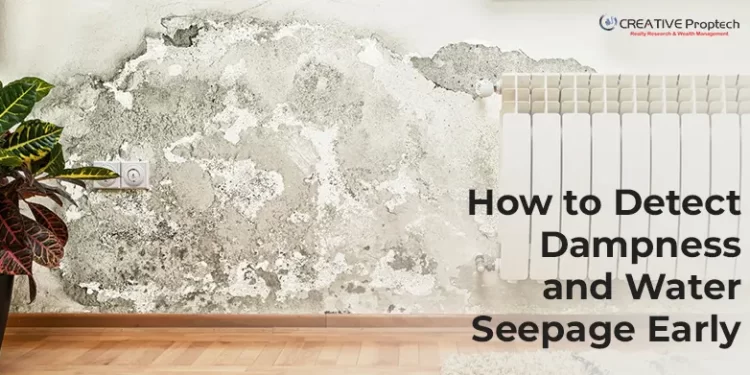Water seepage and dampness are among the most common—and overlooked—issues in Indian homes. Whether it’s a newly constructed flat or a decades-old resale apartment, hidden moisture can silently damage your property and health. Acting early is not only preventive—it’s smart ownership.
Here’s how to Detect Dampness and Water Seepage Early become expensive repairs.
Use of Moisture Meters and Infrared Cameras
If you’re unsure whether a patch is truly damp, professional home inspectors use:
-
Moisture meters to check internal wall humidity
-
Thermal imaging cameras to detect cold, damp areas not visible to the naked eye
-
Spirit levels to detect floor settling due to water ingress

Peeling Paint or Wallpaper
-
Damp walls often cause paint and wallpaper to peel, flake, or blister.
-
This is a common issue near bathrooms, kitchens, and outer-facing walls.
Tip: Tap the wall—damp areas may feel cold or sound hollow compared to dry patches.
Mold or Fungal Growth
-
Small black, green, or white patches on walls or ceilings indicate mold buildup.
-
Mold thrives in humid, damp conditions and can affect air quality.
Common locations: Behind bathroom mirrors, under kitchen sinks, and ceiling corners.
Musty Odors
-
A consistent damp, earthy smell is often the first sign of water seepage, even before visible damage.
-
Musty odors linger in closed rooms, cabinets, and basements.
Pro tip: Smell around wooden furniture and closed storage areas regularly.
Swelling of Wood or Laminate Furniture
-
Excess moisture causes wooden cupboards, doors, and laminated wardrobes to warp or swell.
-
Check for difficulty in closing cabinet doors or drawers.
Efflorescence on Walls
-
White, chalky salt deposits on external or internal walls mean water is penetrating through the surface and evaporating, leaving behind salts.
-
It’s especially common in older buildings or walls exposed to rain.
Floor Dampness or Softness
-
If floor tiles feel loose or certain patches feel soft or cooler, there may be underlying dampness.
-
Often seen near bathrooms, balconies, and utility areas.
Cracks in Walls or Ceiling Corners
-
Fine cracks near ceilings or wall joints might signal trapped moisture.
-
In monsoon-prone areas like Mumbai or Pune, moisture can travel across surfaces invisibly and show up months later as structural stress.
Visible Wall Discoloration or Stains
-
Yellowish or brown patches on walls, especially near ceilings or windows, are early signs of water seepage.
-
Paint that looks uneven or appears to “bubble” can be caused by trapped moisture.
Where to look: Behind beds, wardrobes, and wall-mounted furniture that block air circulation.
When to Act
-
Before possession of a new home
-
During monsoon season
-
Before buying a resale property
-
After plumbing or waterproofing repairs
-
If you notice sudden increase in moisture or smell
Preventive Tips
-
Ensure adequate ventilation in all rooms
-
Don’t block walls with large, air-tight furniture
-
Regularly inspect bathrooms and window corners
-
Schedule an annual professional home inspection
Conclusion
Early detection of dampness and seepage can prevent massive repair bills and health concerns. Don’t wait for visible mold or crumbling paint to act. A professional home inspection can give you peace of mind and ensure your home is dry, safe, and structurally sound.
FAQs
1. Can I detect dampness myself without professional tools?
You can spot surface-level signs like paint bubbles or odors, but deeper moisture often requires infrared imaging or moisture meters that only professionals use.
2. Is thermal imaging really necessary?
Yes. It can detect hidden moisture inside walls or ceilings without breaking anything, making it ideal for early detection.
3. Are certain areas in a home more prone to seepage?
Yes—bathrooms, balconies, exterior-facing walls, and flat roofs are common hotspots for water seepage.
4. Does seepage mean poor construction?
Not always. Seepage can be due to blocked drains, harsh monsoons, poor ventilation, or lack of regular maintenance.
5. What’s the cost of a professional damp check?
It varies by property size and service type. You can request a quote based on your location and inspection requirements.






